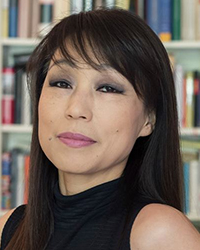 Last year, in my article about the Total Immersion day devoted to the music of Unsuk Chin, i didn’t say much about the Violin Concerto, which was omitted from the BBC’s broadcast. However, in November they finally got round to broadcasting it, so here it is. The performance, at the Barbican in London, was given by Jennifer Koh with the BBC Symphony Orchestra, conducted by Ilan Volkov. In the concert hall, Koh’s violin often struggled to be heard above the considerable orchestral forces pitted against it, so it’s good to hear the balance so nicely restored in the broadcast.
Last year, in my article about the Total Immersion day devoted to the music of Unsuk Chin, i didn’t say much about the Violin Concerto, which was omitted from the BBC’s broadcast. However, in November they finally got round to broadcasting it, so here it is. The performance, at the Barbican in London, was given by Jennifer Koh with the BBC Symphony Orchestra, conducted by Ilan Volkov. In the concert hall, Koh’s violin often struggled to be heard above the considerable orchestral forces pitted against it, so it’s good to hear the balance so nicely restored in the broadcast.
Despite being composed in a familiar, four-movement plan, it’s a piece rather difficult to unpick. In some ways, the textures are simpler and more defined than usual, but this is countered by material that is highly organic. It opens in a dense place, lower notes moving vaguely while the soloist draws a high line filled with open strings and natural harmonics. The brass are the first to become apparent, chords shifting in the background, their movement causing everything momentarily to swell, and then halt. The soloist’s first cadenza is wiry and (in the best sense) aimless, its twists and swoops more a result of fun than purpose. But Chin is just as concerned with momentum as with reverie, and she soon pushes the violin back into a pace that becomes ever more swift, culminating in a moto perpetuo that’s urged on by orchestral stomps. Another cadenza ensues, more rapid than before, and a sustained brass chord ushers in the movement’s climax, which sends the frantic soloist plummeting. The slow second movement places heavy emphasis on Chin’s trademark use of percussion. The soft opening is exquisite, a harp gently accompanying the violin, while the strings occasionally coalesce around them both. The warm consonance heard here, together with its brightly glittering surface (expanded downwards by gongs) bring to mind the soundworld of Takemitsu, although only in a superficial sense and, indeed, only briefly, as Chin soon moves everyone on in an altogether more tense direction. The violins shiver and buzz around the soloist, and there’s an abrupt shift to lower trills, whereupon a series of harsh but undeniably radiant eruptions begins in the woodwind. As before, slow brass chords cause things to change, this time having a calming effect, reducing both orchestra and soloist to silence.
The Violin Concerto was awarded the prestigious Grawemeyer Award in 2004, and while Chin is undoubtedly worthy of the award, this, of all her pieces, is arguably not the one that should have been singled out for such praise, as it’s let down by the last two movements. While it would be pushing it to describe the previous movements as romantic, there’s nonetheless a rather breathless, heady lushness to the music which serves to support the diverse assortment of melodic strands that continually occupy the soloist. But the third and fourth movements more or less dispense entirely with lyricism, opting instead for emphatically gestural material; this, together with their relative brevity (barely half the duration of the first two movements) makes for an unexpectedly disappointing denouement that somewhat undermines the work as a whole.
The blink-and-you’ll-miss-it third movement emerges as hopping fragments from some initial heavy thuds. The violin affects a stab at a melodic line, but—surrounded by wild bangs and crashes on all sides—it’s easily overwhelmed, opting instead simply to ascend to stratospheric heights while the orchestra, rather bizarrely, sounds like it wants to tune up. The final movement is no less troubled, lurching along through its opening minutes, preoccupied with high registers. Chin does then spend some time rekindling the warmth heard earlier, but it’s swiftly dissipated as the orchestra grows restless and starts chattering over the soloist, breaking its line. The conclusion, though, is excellent; another sustained brass chord causes a similar effect to that in the first movement, agitating the soloist to a fever pitch while the woodwinds chirrup and flourish like crazy—this time, in sympathy with the violin rather than in spite of it. After the final climax all fades to a shimmer, and the violin briefly touches on its open string idea from the start.
The audio has been removed as a commercial recording is now available.

[…] as addendum to my coverage of last year’s Total Immersion Day devoted to Unsuk Chin (part 1, part 2), here is one of the few remaining pieces from that day, which was only broadcast a few weeks ago. […]